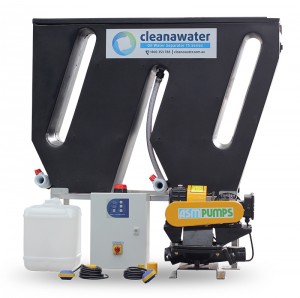Choosing an oil water separator that meets your industry requirements
Industries that use or produce oils generate a considerable amount of waste that contains numerous pollutants including oil and other suspended solids. Australian water authority policies require that pretreatment devices are installed to reduce the quantity of pollutants in the water being discharged.
An oil seperator can efficiently aid in the removal of free oils, grease and hydrocarbons from waste water and are commonly used in industrial and commercial applications. When correctly designed and installed they function as an efficient treatment system to ensure that wastewater adheres to discharge standards. Applications that commonly use oil water separators include washbays, AQIS (Quarantine), mining and all washdown applications.
Oil water separators use a variety of technologies such as coalescing, VGS, hydrocyclone, induced cyclonic and below ground solutions. Choosing the right technology depends on your business needs and the quantity and intensity of generated waste. Factors to consider include flow rates, oil concentrations, performance requirements and available space as well as whether they have been approved by water and regulatory authorities.
Coalescing oil separators are generally available in a range to suit all budgets and are constructed with stainless steel and/or polyethylene. They are quick and easy to install, require minimal maintenance and are ideal for outdoor installation. They come in non emulsifying pumps, float switches and controllers, in a large range from 1,000 to 50,000 litres per hour.

Vertical gravity separators (VGS) are generally constructed in high quality stainless steel. They range from 700 to 3000 litres per hour and have a small diameter for small footprint applications. These separators are adaptable to handle hot oils and grease such as those discharged from hospitality applications. Like coalescing separators they come in complete packages including non emulsifying pumps, float switches and controllers, are easy to install, require minimal maintenance, are ideal for outdoor installation and come in a range to suit all budgets.
Hydrocyclone oil separators use the compact oily water treatment method and are ideal for large scale oily water removal. They work on a large range from 2000 to 50,000 or more litres per hour and with no moving parts, require the most minimal maintenance of all oil water separators. Hydrocyclone oil separators use electric or pneumatic operation that makes them suitable for hazardous or remote areas. They are generally up to 90% smaller than traditional oily water separator systems and are adaptable to suit water recycling and reuse.
Induced cyclonic separators are commonly used in water recycling environments to substantially reduce water usage. They are a generally cost effective solution and feature plug and play factory pre-commissioned systems. These separators come in skid mounted treatment systems in a range from 3,000 to 12,000 or more litres per hour.
To find out which technology best suits your business, consider the different features and benefits of each as well as the cost and effort involved in installation, operation and maintenance. A professional oil water separator company can assist you in choosing the right separator.
Many thanks to the team at Cleanawater for helping with this article.
